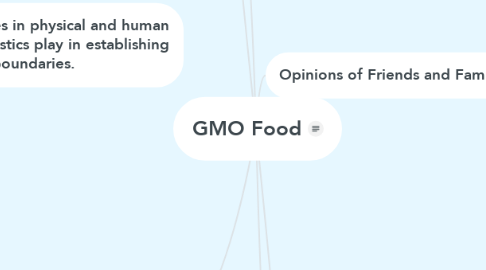GMO Food
저자: Alison Clawson Fitzgerald

1. Cons
1.1. Increase in food allergies
1.2. Removed from natural state
1.3. Uncertainty on how GMO can effect our bodies or the environment in the future.
2. How people organize into a range of political structures at different scales?
2.1. Some political stances are that GM foods could represent one of the biggest advances ever achieved in farming
2.2. Others GM foods could trigger a wide variety of serious environmental and health problems
3. What roles in physical and human characteristics play in establishing political boundaries.
3.1. Those who make a living from raising food push for policies that allow food to grow quickly and in a way that looks more appetizing
3.2. Those who work with world hunger want crops more readily available and easy to grow
3.3. Some push for policies that prevent GMOs and using Insecticides because they could have a negative effect on the environment
4. How GMOs effect the economy
4.1. "At the global level, GM technology has had a significant positive impact on farm income, with in 2012, the direct global farm income benefit being $18.8 billion. This is equivalent to having added 6% to the value of global production of the four main crops of soybeans, maize, canola, and cotton." (ncbi.nlm.nih.gov)
4.2. "GM crops could impact food availability by providing seeds which are resistant to adverse climate conditions; have an effect on food access by increasing farmers’ incomes; and, under the same food utilization conditions, bio-fortified crops could increase the nutritional status of households worldwide." (https://doi.org/10.1186/2047-2382-3-24)
4.3. According to the International Journal of Food Contamination, almost 400 cases of GMO contamination occurred between 1997 and 2013 in 63 countries." "Contamination can spark dramatic economic losses for farmers who face rejection from export markets that ban GMOs." (farmaid.org)
5. What does GMO mean?
5.1. Genetic modification: The production of heritable improvements in plants or animals for specific uses, via either genetic engineering or other more traditional methods. Some countries other than the United States use this term to refer specifically to genetic engineering. (usda.gov)
5.2. GMO: An organism produced through genetic modification. (usda.gov)
6. Pro
6.1. Increase food supply
6.2. Larger crops
6.3. Healthier crops
7. Opinions of Friends and Family
7.1. "I think that genetic modification is something we've been doing for a long time, and that the negativity surrounding it is blown out of proportion."
7.2. "There are great benefits to it but it also has a negative side. If a corn is modified so that bugs don't want to eat it, I doubt it is good for human consumption. I prefer foods as close to their natural state as possible."
7.3. "I prefer not to use or consume them. I don’t think they have been sufficiently tested to prove that there are no negative side effects."
7.4. "Stop eating glyphosate sprayed GMO foods. Eat whole foods, mostly plants."
7.5. "Genetically modified and hybridized are separate things from what I have studied. Your body breaks down any foods to use the individual atoms and elements to rebuild cells and genetically modified foods can harm you because it then uses the genetically modified parts in your DNA which will then replicate and increase the number of genetically modified genes in your DNA. I believe this is one of the big reasons the number of diseases are continually increasing. Each person's DNA interacts differently with genetically modified DNA of the foods and creates new symptoms, many of which cannot be identified until much later if at all. Not to mention the nutritional deficiencies this creates... We have given control of our food and crops to companies like Monsanto who care more about profit margins than our health."
7.6. "It sounds like it’s a good idea that could go bad if not kept under control"


